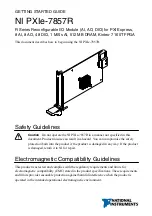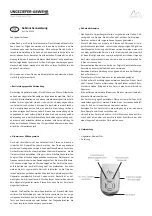
7 PICOSCALE CONTROL GUI
•
NAND
or
NOT AND
The output becomes LOW if both inputs are HIGH. In all other
cases, the
output is H
I
GH.
•
XOR
The output becomes LOW if both inputs are simultaneously H
I
GH or simultaneously
LOW.
I
n all other cases, the output is H
I
GH.
•
NXOR
or
NOT XOR
The output becomes H
I
GH if both inputs are simultaneously H
I
GH or
simultaneously LOW.
I
n all other cases, the output is LOW.
NOTICE
I
f you simply want to pipe through a trigger source as a trigger output signal,
select the corresponding trigger source in the AND Mask, do not select anything
in the OR Mask (so that its output is always LOW) and combine the two masks by
an OR operation in the
Logic Operation
.
Finally, you have to con
fi
gure the
Output Mode
and
Output Delay
of your trigger signal. Some trigger
sources simply create short pulses or the trigger condition may be subject to high frequency state
changes.
I
n order to debounce or widen the pulses you can select an appropriate
Output Mode
as well as an
Output Delay
. The
PICO
SCALE
o
ff
ers four di
ff
erent
Output Modes
, which are also
illustrated in
fi
gure 7.12:
•
Immediate No Reset:
I
n this mode the output control logic forwards a change of the trigger
state immediately and the state is kept stable for the con
fi
gured delay.
•
Immediate Reset:
I
n this mode the output control logic forwards a change of the trigger
state immediately and the state is kept stable for the con
fi
gured delay. A state change during
this delay resets the delay counter.
•
Delayed No Reset:
I
n this mode the output control logic starts a delay counter when the
trigger state changes. State changes during this delay are ignored. At the end of the delay
the current state is forwarded.
•
Delayed Reset:
I
n this mode the output control logic starts a delay counter when the trigger
state changes. State changes during this delay are ignored, but cause the delay counter to
be reset. At the end of the delay the current state is forwarded.
Note that the output mode only takes e
ff
ect when a non-zero output delay is con
fi
gured. When
the output delay is set to zero (default), the resulting trigger signal is identical to the input signal.
The output modes are divided into two categories,
Immediate
and
Delayed
.
Immediate
performs a
state change of the trigger output immediately after a state change of the input signal is recorded.
Delayed
on the other hand keeps the current trigger state and waits for a certain time until the
trigger output reacts on an input signal state change.
The subcategories
Reset
and
No Reset
determine how the entered
Output Delay
is taken into ac-
count by the trigger system. Once a state change of the input signal is recorded, a delay counter is
started.
I
n the
No Reset
case this counter runs independently of the input signal, thus deactivating
the trigger output for a
fi
xed time.
I
n case of
Reset
, the delay counter is restarted every time the
input signal changes its state. Thus, this mode guarantees that the trigger output remains in its
current state until the input signal is stable for the de
fi
ned
Output Delay
time.
61
PicoScale User Manual
Содержание PICOSCALE
Страница 1: ...PICOSCALE USER MANUAL www smaract com...
















































